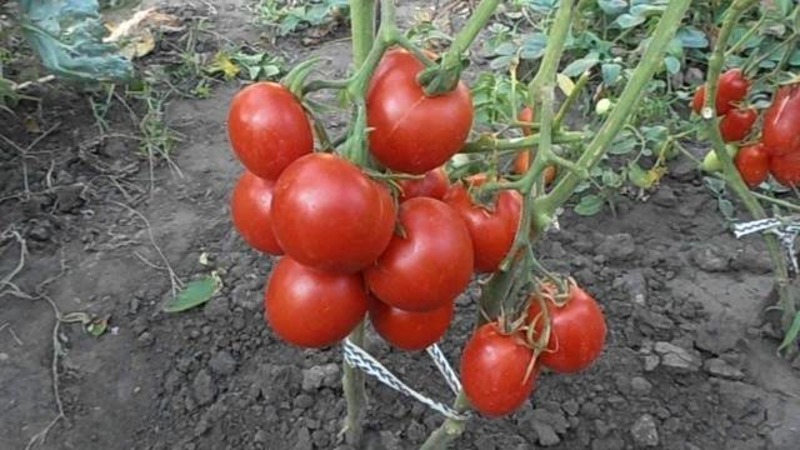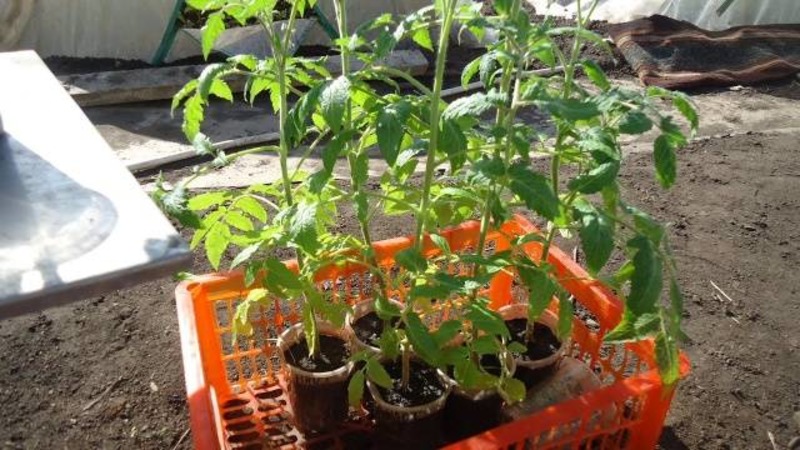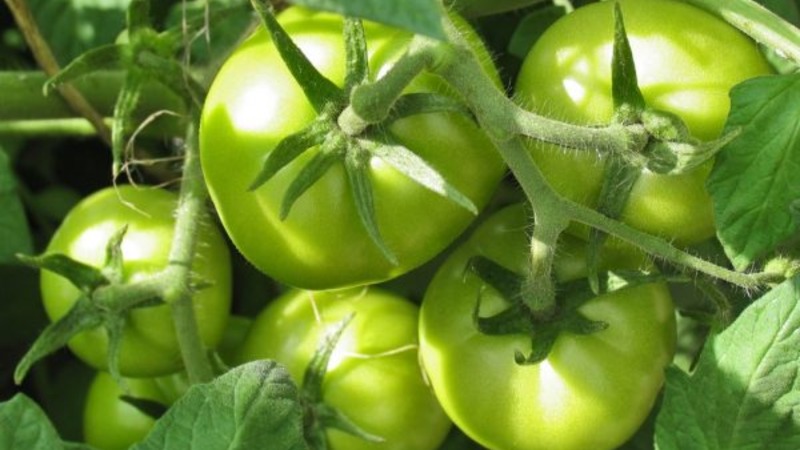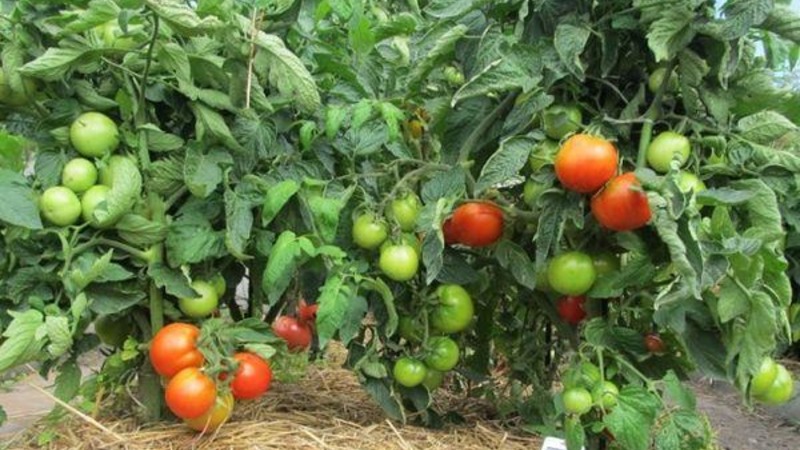An unpretentious and non-capricious variety that requires minimal maintenance - the "Tolstushka" tomato: we grow without hassle
The fatty tomato was bred specifically for regions with an unfavorable climate. It has established itself as a high-yielding variety that is immune to many diseases. Agrotechnics throughout the growing season are so simple that every beginner who wants to grow a tomato with excellent taste on his site can cope with it.
The content of the article
Characteristics and description of the variety
The Tolstushka variety of the Siberian Garden agrofirm is intended for regions with a harsh climate. Differs in endurance and adaptability to adverse conditions.
Reference.Agrofirm "Siberian Garden" has been a leader in the seed market for many years.

Distinctive features
The bush is determinate, compact, no more than 80 cm high. The stem is strong, the foliage is medium, the leaves are small, dark green in color. The first brush is formed after 9 leaves, 8 fruits are tied on each brush. The inflorescences are simple.
Medium early variety, from the moment of planting to full maturation, 115-120 days pass.
It is immune to the main diseases of the Solanaceae family. Recommended for growing in open ground and in greenhouses.
The yield is high: up to 7 kg of fruits are harvested from 1 bush, provided that 3-4 seedlings are planted per 1 sq. m.
Despite the low growth, the plant requires a garter, otherwise the branches will not withstand the weight of ripe fruits. Culture needs pinning. For the best quantitative indicator, the bush is formed into 2 stems.
Fruit characteristics
The fruits are large, with an average weight of 200-250 g, flat-round shape, red in color. The taste is sweet, with barely noticeable sourness, the pulp is juicy, the skin is dense. There are 4 seed chambers, few seeds.
The use in cooking is universal: the fruits are well suited for fresh salads and preparations for the winter. Do not lose their taste when processed into tomato products: juices, ketchups, lecho. Smaller tomatoes are used for whole fruit canning. Tomatoes go well with other vegetables.
They are subject to long-term storage and perfectly retain their appearance during long-term transportation.
The photo shows the fatty tomatoes.

How to grow seedlings
Sowing seed begin 2 months before planting seedlings in the ground. This culture belongs to a hybrid, so seeds for planting are purchased each time in specialized stores.
Reference.The seeds of hybrid crops do not retain their parental properties, therefore, independent harvesting for subsequent plantings does not make sense.
Seed preparation
First, the seed is checked for external defects. All seeds should be smooth, light in color and free from visible damage. To determine if the seeds are empty or not, they are dipped in a saline solution. To do this, 1 teaspoon of salt is dissolved in 1 glass of water and placed in the grain solution for 10 minutes. Those seeds that have floated to the surface are not suitable for sowing.
The rest are disinfected in a weak solution potassium permanganate 20 minutes. Then they are washed with running water, wrapped in gauze, slightly moistened and left in a dark and warm place for 3 days, moistening the gauze with warm water as it dries.As soon as the seeds sprout, they are sown in the ground.
Reference.To improve germination, the seeds are soaked in a growth stimulator for 8-10 hours.
Capacity and soil
The soil is prepared from garden soil, peat and sawdust in a ratio of 7: 1: 0.5. For ease, a little washed river sand is added to the soil mixture. After thorough mixing of all components, the soil is fertilized with humus or mullein infusion. The resulting soil is laid out in planting containers, in which small holes are made in advance at the bottom so that excess moisture does not linger.
They are planted in a common wooden box or in separate containers, such as plastic cups, paper honeycombs and peat pots.
Reference.Peat pots contain a complex of nutrients that nourish the sprouts before planting in the ground.

Sowing
Seeds are sown to a depth of 1.5-2 cm at a distance of 3 cm from each other. Then the soil is leveled from above and slightly moistened with a spray bottle. Planting containers are left in a warm and dark room at an air temperature of 22-24 ° C. Containers must be covered with foil or glass to create a greenhouse effect.
Growing and care
When the first shoots appear, the containers are rearranged to a well-lit place. Daylight hours should be at least 12 hours. In case of insufficient natural light, they are supplemented with phytolamps, which are installed at a distance of 30 cm from the seedlings.
The daytime temperature should not exceed 24 ° C, at night 18 ° C is sufficient. The room where the seedling, regularly ventilate, but protect from drafts, which have a detrimental effect on young plants.
Planting containers are watered with warm, settled water as the top layer of soil dries up using a shallow watering can along the edge of the nursery. After watering, the soil is loosened superficially so as not to damage the young roots.
When 2 true leaves appear, the seedlings are dived, seated in separate containers.
Reference.When sowing seeds in peat pots, picking is not required.
3 weeks before transplanting, the seedlings begin to harden in order to quickly adapt to outdoor conditions. To do this, young bushes are taken out into the street for 30 minutes - 1 hour in the daytime. The temperature in the room at night, where the seedlings are brought in, is lowered to 13 ° C. Gradually the time spent on the street is increased to 14 hours.

How to grow tomatoes
After 2 months, the seedlings are ready for transplantation. By this time, young plants reach a height of 25 cm, they have a fully developed root system and at least 6 true leaves.
Landing
The place for the beds with tomatoes is chosen in the fall, taking into account what crops grew on the ground earlier. Tomatoes are planted where legumes, melons, carrots or beets grew before them. Compliance with the rules crop rotation leads to maximum fruiting rate. The soil is fertilized with wood ash and humus.
In the spring, the soil is loosened, removing weeds with roots, and holes are made 15 cm deep.
Landing scheme: 40 cm - distance between seedlings, 50 cm - between rows. For 1 sq. m place 4-5 plants in a checkerboard pattern. This method of planting provides maximum illumination and ventilation for young bushes.
The seedlings are transferred into the holes along with a lump of earth, sprinkled with soil and compacted. Then water the bushes abundantly and do not disturb the bushes for 2 weeks. During this time, tomatoes adapt to new conditions.
Tomato care bbw
Regular watering is established as the seedlings take root in open beds. Watered only with warm, settled water, strictly under the root, without falling on the leaves. The water is pre-defended and heated in the sun in barrels. Before flowering, 5 liters of water are added under each tomato bush.
During the formation of buds, the amount of moisture is reduced to 3 liters, since the excess leads to cracking of the fruit. Watering at least 2 times a week.On hot and dry days, watering is increased up to 3-4 times as the soil dries up.
After each glaze the soil is loosened and hilled. Such an agrotechnical technique not only saturates the soil with oxygen, but also becomes a preventive measure in the fight against late blight and pests.
The first top dressing spend 2 weeks after transplanting seedlings. Poultry manure is a good fertilizer at this stage of development (1:15). But since the fertilizer contains nitrogen, it is not used in the future.
The second feeding is applied when the ovaries are formed. They are fed with a potassium-phosphorus fertilizer, for example, superphosphate and potassium sulfate (40 g of each fertilizer are dissolved in 10 l of water). These microelements are also fed during the fruiting period.
Important! The culture responds well to organic inputs. Universal fertilizer - wood ash... It is added to the water 2 days before watering.

Features of cultivation and possible difficulties
Due to the small number of shoots, the bushes do not need regular pinching, which greatly simplifies maintenance. But for a better quantitative indicator, the plants are formed into 2 stems.
You cannot do without a garter culture, otherwise the branches will not support the weight of ripe fruits. Tie up as needed to wood or metal supports. This not only protects the plants from damage, but also makes harvesting easier.
Diseases and pests
The culture has established itself as highly resistant to the main diseases of the Solanaceae family.
Preventive treatment of plants includes spraying with Bravo preparations or copper sulfate. "Bravo" refers to contact fungicides and protects well against fungal diseases, for example, late blight... Copper sulfate has the same effect.
Decoctions of onion husks and garlic (100 g per 1 liter, insist for 1 day) are saved from viruses and pests. The finished infusion is diluted with water 1:10 and the plants are sprayed. Many pests are deterred by strong odors and decoctions from pungent-smelling herbs. Also, such herbs are planted next to tomatoes, and mustard bushes can scare off even the Colorado potato beetle.
The nuances of growing in open ground and in a greenhouse
The variety is recommended for growing in protected and unprotected ground. The Fat Tomato takes root well in open beds in warm areas and in regions with a temperate climate. Where the summer is short and cold, the culture is cultivated in greenhouses or under covering material.
Protected structures are recommended to be regularly ventilated to avoid the spread of infections and pests. Greenhouse conditions are most favorable for the pathogenic environment, which is destroyed by the regular flow of fresh air.
Experienced gardeners advise to remove the lower leaves, otherwise they can cause damage by late blight. When planting, it is necessary to exclude plant thickening. Frequent planting not only reduces yields, but also leads to the spread of pests.
Harvesting and application of the crop
Ripening begins 90-95 days after the first shoots, but the period of the most abundant yield occurs at 110-115 days and lasts for another 2 weeks. Subsequent fruits weigh less than the first, so they can be used for whole-fruit canning.
Maturation in the brush is almost simultaneous, which makes picking easier. It is not necessary that all tomatoes are fully ripe; tomatoes are harvested and pink, they are quite capable of picking up color on their own at room temperature.
Earlier collection of vegetables allows plants to lay new fruitful clusters without depletion.
The use of ripe vegetables is universal: they are consumed fresh, for pickling, pickles, canned food, and processed into tomato products. Tomatoes are good in summer salads, hot and vegetable dishes, baked with meat, perfectly complement the taste of other vegetables.They make excellent juices, pastes, ketchups, adjika, lecho. Vegetables do not lose their flavor in pickles and marinades.
Thanks to their dense skin, tomatoes are subject to long-term storage and can withstand long-term transportation without losing their appearance and taste.

Advantages and disadvantages of the variety
The Fatty Tomato has many positive qualities:
- unpretentious care;
- immunity to diseases;
- the ability to take root in any climatic conditions;
- does not require compulsory pinching;
- high rate of fruiting;
- great fruit taste;
- amicable maturation;
- universal use;
- long-term storage;
- long transportation.
The disadvantages of culture include the obligatory garter.
Farmers reviews
The farmers' comments are unanimous: everyone claims that the crop is able to take root and give a good harvest in areas with harsh climatic conditions. This is an important factor for residents of the northern regions. The opinions of those who planted this variety:
Diana, Leningrad region: “The fat woman was planted in a film greenhouse, when it gets cold you can close it and not worry about the safety of the crop. The fruits are large, moderately dense, with fragrant and juicy pulp. The plant is low, takes up little space in the greenhouse. Minimal care: enough watering and feeding. You don’t need to step-son. ”
Alexander, Krasnoyarsk: “I am constantly looking for high-yielding large-fruited tomatoes. I grow different types for sale. I really liked the fatty tomatoes according to the description and photos, so I allocated a separate garden for them. The bushes are not tall, but the fruits are large and heavy. I collect 5-6 kg from a bush. Of course, I breed only in a greenhouse. "
Conclusion
Tomato Tolstushka is an irreplaceable variety for residents of the northern regions who are deprived of the opportunity to pamper themselves with heat-loving vegetables. The variety is distinguished not only by its endurance and adaptability to adverse factors, but also by its high yield, immunity to many diseases, and ease of care. It is ideal for experienced gardeners and beginners looking for a great harvest without a lot of effort.